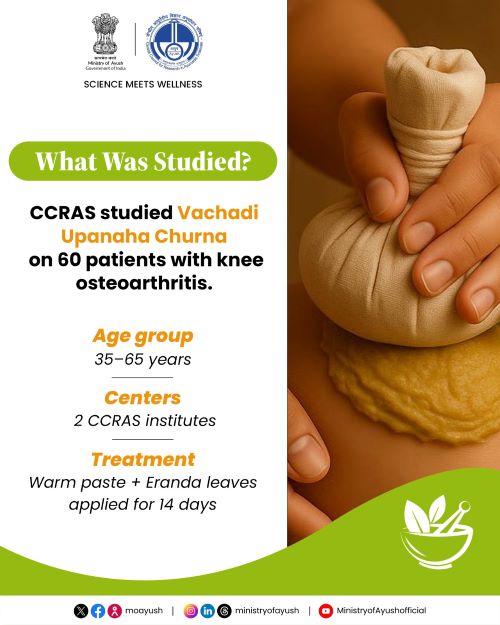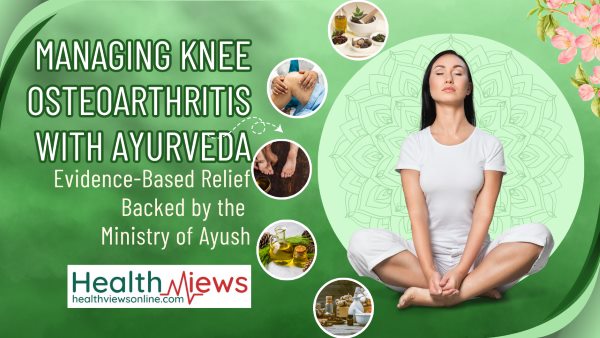Osteoarthritis (OA) of the knee—the world’s most common degenerative joint disorder—affects millions of people, limiting mobility, causing pain, and diminishing quality of life. As the burden of Knee Osteoarthritis rises globally, patients are seeking safe, effective, and holistic management strategies. Ayurveda, India’s traditional system of medicine, is stepping into the spotlight—backed not only by centuries of practice but also by modern clinical evidence.
What is Ayurveda’s Approach to Knee Osteoarthritis?
In Ayurveda, osteoarthritis is often linked to Sandhigata Vata—a condition caused by the aggravation of Vata dosha, leading to joint pain, stiffness, and reduced flexibility. Rather than merely suppressing symptoms, Ayurvedic therapies aim to restore balance, improve joint lubrication, and slow degeneration—offering long-term relief without heavy reliance on painkillers.
The Central Council for Research in Ayurvedic Sciences (CCRAS), under the Ministry of Ayush, Government of India, has been working to validate these traditional interventions through rigorous studies. Recent research highlights two landmark findings on Ayurvedic therapies for OA: clinical efficacy and safety.
Vachadi Churna Upanaha for Knee Osteoarthritis: A Traditional Therapy with Modern Proof
A recent clinical study, published in the Journal of Research in Ayurvedic Sciences, evaluated Upanaha therapy using Vachadi Churna for managing OA of the knee.
What is Upanaha?
Upanaha is a classic Ayurvedic treatment involving the application of a warm poultice (paste pack) to the affected joint. In this trial, a paste made of Vachadi Choorna, Saindhava (rock salt), Mahanarayana oil, and Dhanyamla was applied over the knee, layered with warm Eranda leaves, bandaged, and left on for about 12 hours daily—for 14 days.What did the study find?
- Pain Reduction: Visual Analog Scale (VAS) scores dropped by over 50%—from 64.48 at baseline to 31.95 after therapy.
- Stiffness Relief: Joint stiffness scores fell sharply (VAS 39.68 → 16.0).
- Functional Improvement: The WOMAC (Western Ontario and McMaster University Osteoarthritis Index) score improved significantly—from 48.02 to 26.98, reflecting better mobility and daily activity performance.
Importantly, relief was sustained even a week after treatment, suggesting that Ayurveda’s effects extend beyond temporary symptom suppression.

Is Ayurveda Safe for Long-Term OA Care?
Alongside proving efficacy, CCRAS also addressed an equally critical question: Are Ayurvedic formulations safe for OA patients?
In a multi-center safety study, ten classical formulations—including Yogaraj Guggulu, Narayan Taila, Dashmoola Ghrita, and Maharasnadi Kwatha—were assessed across patients of different ages, genders, and health backgrounds.
The findings were reassuring:
Liver and kidney function tests (LFTs & RFTs) stayed within safe limits.
No adverse drug reactions were reported.
This robust safety profile means Ayurvedic interventions can be confidently considered for long-term management—something critical for chronic conditions like osteoarthritis.
Also Read: Guggul Heath Benefits, Medicinal Uses, Precautions & Side Effects
Why This Matters for OA Patients
Conventional OA treatments—painkillers, steroid injections, and eventually knee replacement—come with side effects, costs, and risks. Ayurveda offers a complementary or alternative path that is:
Natural & Non-invasive – avoiding heavy chemical loads on the body.
Evidence-Based – backed by measurable clinical results.
Safe for Long-Term Use – with no significant impact on vital organs.
Managing Knee Osteoarthritis with Ayurveda: Ministry of Ayush Leading the Way
This research is part of a broader initiative by the Ministry of Ayush to bring Ayurveda into mainstream healthcare through evidence-based validation. By funding and overseeing CCRAS studies, the ministry is ensuring that Ayurvedic therapies are not only traditional but also trusted—backed by data, clinical trials, and safety checks.
For OA patients, this means Ayurvedic care is moving beyond anecdotal remedies to become an integrated, research-backed option within modern medicine.
Conclusion
Ayurveda is moving beyond anecdotal reputation into evidence-driven medicine. With therapies like Vachadi Churna Upanaha showing powerful pain and stiffness reduction, and safety studies confirming no harm to liver or kidney health, the Ministry of Ayush’s efforts are paving the way for Ayurveda to become a trusted ally in the global fight against knee osteoarthritis.
For millions struggling with OA, this is more than alternative medicine—it’s an integrative, hopeful, and proven path to better living.

References
Makhija D, Deep VC, Mata S, et al. Clinical Evaluation of Upanaha with Vachadi Churna in the Management of Osteoarthritis Knee. Journal of Research in Ayurvedic Sciences. 2020; 4(4):149–157.
Mata S, Khanduri S, Ota S, et al. Clinical Safety of Selected Ayurvedic Formulations in Osteoarthritis. Journal of Research in Ayurvedic Sciences. 2020; 4(4):139–148.




